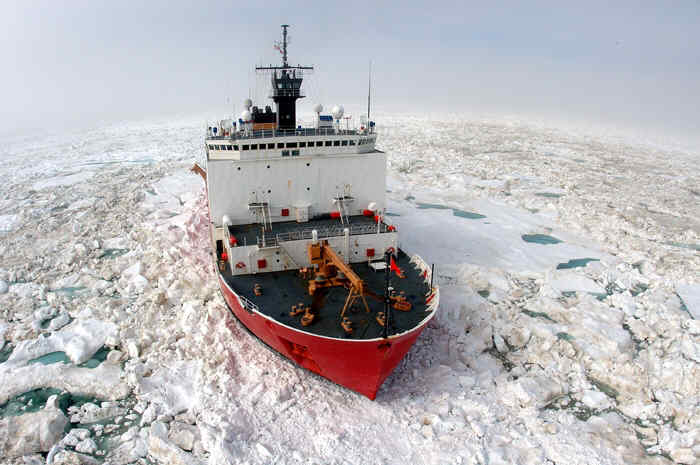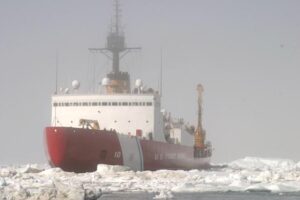Coast Guard Acts On Icebreakers; Releases Requirements
Posted on

Coast Guard icebreaker Healy
[UPDATED with Adm. Papp comments] SURFACE NAVY ASSOCIATION: In an important step to filling the increasing gap between American’s Arctic strategy and our capabilities, the Coast Guard has released its “notional program schedule [and] notional Polar Icebreaker requirements” for two new heavy icebreakers today.
“This will be available to industry at noon today and I’m sure industry will rise to the challenge…. when it comes to heavy icebreakers,” Commandant Adm. Paul Zukunft told the Surface Navy Association this morning. America’s Arctic archrival Russia, with one-eighth our GDP, is building 14 icebreakers and already has 42, he said pointedly. The US has just two — one medium, the Healy (pictured above) and one 40-year-old heavy, the Polar Star (below)– and is planning to build another pair.

Coast Guard icebreaker Polar Star
Today’s release does not address how to pay for the ships. “The biggest piece that’s not in it is where’s that wedge [of funding],” said Zukunft. “It’s in the ’17 budget” — which he can’t discuss because it isn’t yet public (or even entirely finalized). But he wouldn’t have staffed up an acquisition office or put forth an acquisition strategy without high confidence that the money will materialize, the Coast Guard commandant said. President Obama has personally called for accelerating the construction of icebreakers, plural, Zukunft noted: “I’m pretty sure I heard an ‘s’ on the end of that.”
[UPDATE: “I think everybody’s going to be pleased when they see the president’s budget this year,” said retired Adm. Robert Papp, the previous Commandant of the Coast Guard and now the State Department’s special representative for the Arctic. “He was the first sitting president to set foot in the Arctic, [and] he made a commitment[:] He didn’t say new icebreaker, he said new icebreakers, plural.”
[“We certainly need more than one, and we need more than two in order to fulfill our responsibilities as an Arctic and Antarctic nation,” Papp told the Surface Navy Association this afternoon.]
The Coast Guard also enjoys strong support in Congress, although that has not yet translated into action on icebreakers. That may be changing. “I spent half the day on the Hill yesterday, he said, “[and] every member wanted to know more about icebreakers.” Congress has also funded a ninth National Security Cutter, the commandant noted, after his predecessors had struggled just to protect the originally planned eight.
[UPDATE: “My goodness, the omnibus [appropriations] bill that just came out” increased Coast Guard acquisitions funding to $1.9 billion, roughly double its historic levels, Papp said].
Meanwhile, the buildup continues on the other side of the North Pole. In addition to its icebreakers, Russia is also building a line of bases along its Arctic coast, where maritime traffic has increased fourfold as the ice melts. The US has no comparable shore infrastructure on the northern shore of Alaska, no land bases for aircraft or short-range patrol boats, Zukunft said, so icebreakers will be even more essential as everything from mobile command posts to self-sufficient rescue vessels.
“Up on the north slope of Alaska, there is no shore infrastructure to really speak of,” Zukunft told me after his formal remarks, “so this [ship] becomes your floating infrastructure.”
In fact, the requirements for the icebreakers — derived not just from the Coast Guard’s needs but a half-a-dozen different agencies’ — envision ships with a level of self-sufficiency and flexibility “very similar,” in Zukunft’s words, to the fictional starship Enterprise, which would conduct scientific exploration one day and fight Klingons the next, almost always alone and unafraid with the rest of Starfleet far away.

Adm. Paul Zukunft
“Can it do scientific support? Absolutely. Can it exert sovereignty? Yeah, we need to do that as well. Can it do law enforcement? Can it respond to mass rescue environment? Can it accommodate helicopters?” Zukunft said. “Can you surge and bring additional people on [when missions change]? If you’re a floating command center standing a very complex watch, you’re going to need more people.”
The future icebreakers need to be so versatile because they will rarely be able to count on outside help. Even with the polar ice cap receding, icebreakers are the only vessels that reliably access the Arctic and enforce American claims there to oil, gas, and seabed minerals in our Exclusive Economic Zone.
[UPDATE: “You have to as a country have assured access to your maritime environments,” Papp said. “Granted the periods of open water are increasing over time and will continue to increase, but for the foreseeable future, for the next 50 years, there’s going to be ice there, and in order to carry out of our sovereignty responsibilities, we have to be able to get in there and get out.”]
While the Arctic may be rife with competition but it is also a place where extensive international cooperation occurs. Zukunft emphasized the possibility of Arctic cooperation with Russia. To avoid “a military confrontation in the arctic domain,” he’s reaching out to his Russian counterparts — and politely suggesting the US Navy leave the Arctic to the less threatening Coast Guard. “I do not recommend that the Navy goes to the Arctic [or] that the Navy invests in icebreakers,” he said. “This has been a Coast Guard mission of long standing.”
That said, Coast Guard icebreakers should not be funded at the expense of the Navy, Zukunft said. “I do not advocate we go after the Navy shipbuilding budget, The Navy’s got to preserve a wedge because you need to recapitalize our nuclear deterrent [with the Ohio Replacement Program submarine],” he said — “but these icebreakers are strategic assets too.”

Retired Adm. Robert Papp, US Special Representative for the Arctic, at a summit in Iceland.
[UPDATE: Committing to icebreakers also sends a strategic message to the other Arctic countries, Papp said. “I said this in the meeting I was at the White House this morning[:] everybody is very excited about United States leadership” [of the multinational Arctic Council, but] they’re skeptical about United States commitment to the Arctic.”
[Again and again, Papp said, foreign counterparts would tell him, “you can’t even get an icebreaker built. How committed is the United States to the Arctic?” Well, the answer to that question just changed.]
Subscribe to our newsletter
Promotions, new products and sales. Directly to your inbox.
